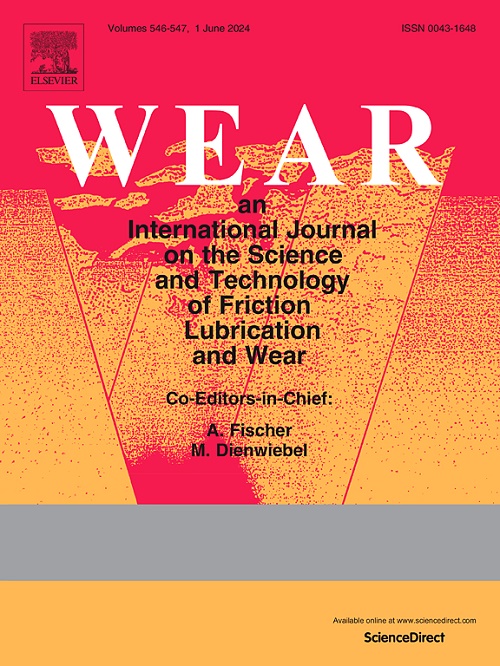Tribo-oxidation mechanism of gradient nanostructured Inconel 625 alloy during high-temperature wear
IF 5.3
1区 工程技术
Q1 ENGINEERING, MECHANICAL
引用次数: 0
Abstract
The tribo-oxidation layer is typically formed at the contact interface of high temperature wear, which exhibits a significant effect on the friction behavior of gradient nanostructured (GNS) materials. This study systematically investigated the wear resistance, near-surface microstructure, and compositional changes of ultra-thick GNS Inconel 625 alloy subjected to surface mechanical rolling treatment (SMRT) under high-temperature sliding wear conditions. The experimental results indicated that as the temperature increased to 500 °C, a tribo-oxidation layer was formed on the surface of the GNS sample, thereby resulting in an abnormal increase in the coefficient of friction (COF) and a rapid decrease in the wear rate. The gradient nanostructures facilitated oxidation diffusion channels, promoting the formation of a protective Cr2O3 film and spinel oxides, reducing the wear rate. At lower temperatures, a rapidly formed Cr2O3 film shielded the matrix, forming a tribo-oxidation layer composed of Cr2O3 and nickel. At 800 °C, the tribo-oxidation layer exhibited complex structures, including glaze, spinel oxide, Cr2O3, and Cr2O3/Ni mixed layers. This complexity was attributable to the oxidation diffusion rate of the gradient nanostructures and tribo-oxide layers. The findings not only elucidated the tribo-oxidation mechanism of GNS nickel-based superalloys but also offered valuable insights for designing wear-resistant materials.
梯度纳米结构 Inconel 625 合金在高温磨损过程中的三氧化机制
三氧化层通常形成于高温磨损的接触界面,对梯度纳米结构(GNS)材料的摩擦行为有显著影响。本研究系统地研究了在高温滑动磨损条件下进行表面机械滚动处理(SMRT)的超厚 GNS Inconel 625 合金的耐磨性、近表面微观结构和成分变化。实验结果表明,当温度升高到 500 ℃ 时,GNS 样品表面形成了三氧化层,从而导致摩擦系数(COF)异常增大,磨损率迅速降低。梯度纳米结构促进了氧化扩散通道,促进了保护性 Cr2O3 膜和尖晶石氧化物的形成,降低了磨损率。在较低温度下,迅速形成的 Cr2O3 膜对基体起保护作用,形成由 Cr2O3 和镍组成的三氧化层。800 °C 时,三氧化层呈现出复杂的结构,包括釉层、尖晶石氧化物、Cr2O3 和 Cr2O3/Ni 混合层。这种复杂性可归因于梯度纳米结构和三氧化层的氧化扩散速度。研究结果不仅阐明了 GNS 镍基超合金的三氧化机制,还为设计耐磨材料提供了宝贵的见解。
本文章由计算机程序翻译,如有差异,请以英文原文为准。
求助全文
约1分钟内获得全文
求助全文
来源期刊

Wear
工程技术-材料科学:综合
CiteScore
8.80
自引率
8.00%
发文量
280
审稿时长
47 days
期刊介绍:
Wear journal is dedicated to the advancement of basic and applied knowledge concerning the nature of wear of materials. Broadly, topics of interest range from development of fundamental understanding of the mechanisms of wear to innovative solutions to practical engineering problems. Authors of experimental studies are expected to comment on the repeatability of the data, and whenever possible, conduct multiple measurements under similar testing conditions. Further, Wear embraces the highest standards of professional ethics, and the detection of matching content, either in written or graphical form, from other publications by the current authors or by others, may result in rejection.
 求助内容:
求助内容: 应助结果提醒方式:
应助结果提醒方式:


